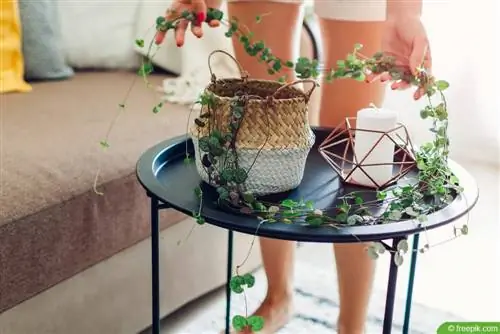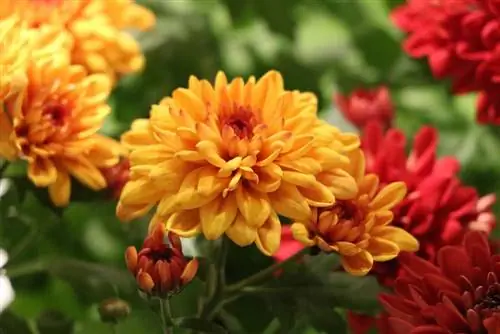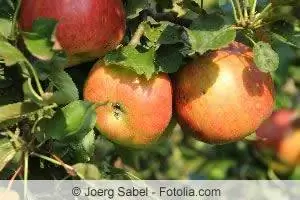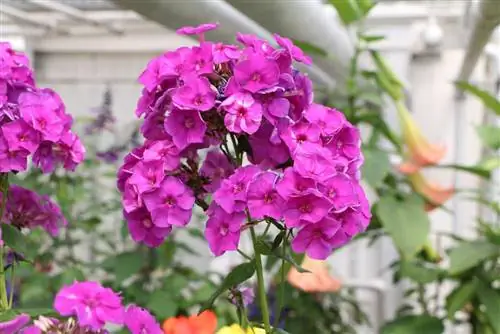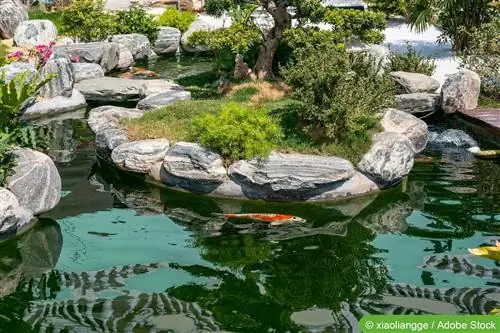- Author admin [email protected].
- Public 2023-12-17 03:39.
- Last modified 2025-06-01 06:48.
Named after its extraordinary flowers, the candlestick plant is a decorative highlight with amazing vigor. Undemanding and easy to care for, it forgives many cultural mistakes. This makes it ideal for beginners and anyone who otherwise seems to have little luck with houseplants. Nevertheless, the Ceropegia woodii obviously has some special requirements in terms of care and location, especially if it is to be propagated itself and should bear flowers for a long time.
Location
The candlestick plant is anything but picky when it comes to location. Full sun or light shade, directly on the windowsill or in the corner of a room - Ceropegia woodii thrives in many places. You don't have to pay attention to humidity or temperature either, because the heated living room is just as good all year round as a cooler place in the hallway.
However, the candlestick plant feels most comfortable in the sun and at temperatures between 20 and 25 °C. Then it also shows numerous flowers. In the shade, however, the flowering power decreases.
Tip:
Since the candlestick plant can grow shoots up to two meters long, it should be raised or grown as a hanging basket plant. Otherwise, when choosing the location, care must be taken to ensure that the stems do not become a tripping hazard.
Substrate
As a succulent, the candlestick plant is able to store water reserves in some thick-fleshed leaves and tubers in the root area. This special feature ensures the survival of Ceropegia woodii in dry times, but also increases the risk of rot if the substrate is too moist or prone to compaction. When choosing soil and planters, good water drainage is important. The substrate should be loose and moderately nutrient-rich. A mixture of potting soil and sand is recommended. To improve drainage, an additional layer of coarse gravel or clay shards can be added to the bottom of the pot.
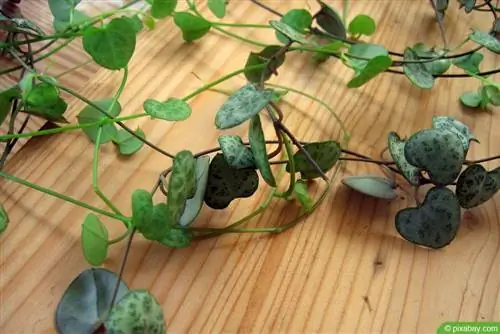
In addition to the substrate, as already mentioned, the vessel itself is also crucial. Shallower bowls are preferable to deep pots. It should also have sufficient drainage holes and in the case of hanging baskets, models with saucers should be chosen that are easily visible and can be easily emptied if necessary.
Pouring
The candlestick plant is in the growth phase from spring to late summer. During this time it can be watered once or twice a week. When it comes to quantities, less is more; the substrate should never be dripping wet afterwards. It is therefore important to ensure that no excess water remains in the pot or saucer.
Of course, the amount and frequency of watering should be adjusted according to the temperature and humidity. In a rather dry living room and in the blazing sun, the Ceropegia woodii naturally needs to be watered more than in a brightly shaded bathroom with high humidity.
Tip:
Soft or stale tap water that is at room temperature is ideal.
Fertilize
The classic candlestick plant grows quite quickly from April to September. Since it reaches shoot lengths of up to two meters, it requires a regular and additional supply of nutrients. Ideally, this is done by adding liquid fertilizer, which is highly diluted and added to the irrigation water. Products are suitable for cacti and other succulents as well as green plants. As a rule, a dose of a quarter of the manufacturer's instructions, administered every two to four weeks, is sufficient.
Wintering
In autumn and winter, the African Ceropegia woodii goes into a resting phase. However, she doesn't have to change location and care becomes even easier than it already was. Watering is reduced to once every one to two weeks. The substrate is allowed to dry well between waterings. Fertilization of the candlestick plant is completely stopped during wintering.
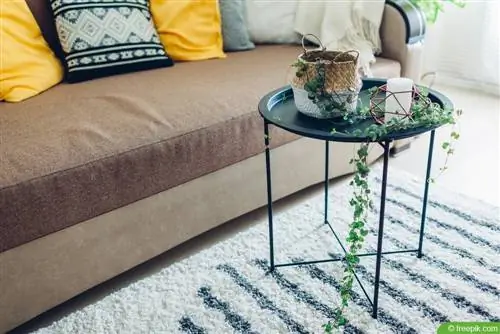
From March onwards, the substrate should be kept moister again. Once the first new shoots are visible, fertilization can be resumed.
Propagation
The propagation of Ceropegia woodii is possible in two ways. On the one hand, through head cuttings, which can be obtained all year round. On the other hand, through so-called breeding tubers.
Cuttings
Propagation via cuttings is quite easy and quickly shows success. The procedure is as follows:
- Separate the ends of the shoots with a length of ten to twenty centimeters - ideally in spring - from the mother plant.
- Let the cuttings rest for about two days so that the cut surfaces can dry. This measure reduces the risk of rot.
- The mixture of potting soil and sand is used as the substrate. Fill it into a flat planter and keep it well moistened.
- The cuttings are inserted about one and a half to two centimeters deep into the soil, leaving a distance of three to five centimeters between the individual shoots.
- The container prepared in this way is moved to a location where the mother plant also thrives.
- In the first few weeks you should only water, but not fertilize. Only when the cuttings can no longer be removed from the soil by gentle pulling or have already shown new shoots can the additional nutrient supply begin.
As an alternative to the separate planter, the cuttings of Ceropegia woodii can also be placed directly in the pot of the mother plant until they have developed roots.
brood tuber
When propagating the candlestick plant via breeding tubers, these must first be obtained. They are found on the leaf nodes of the plant and have a rounded shape, reminiscent of small balls. These can be carefully removed with your fingers. They are then germinated as follows.
- A little potting soil and sand are mixed together as a growing substrate. The ratio should be around 2:1 in favor of the sand. As a top finish, a finger-thick layer of sand or perlite is applied.
- The substrate is lightly pressed into the planter and watered thoroughly or carefully submerged under water until it is completely saturated.
- The breeding tubers are placed on the substrate and pressed in slightly. Since these are light germinators, they must not be covered.
- In the first two months, the substrate should always be kept slightly moist and only allowed to dry slightly between waterings. There is no fertilization in this phase.
Approximately two months should be allowed for both the propagation of the candlestick plant via cuttings and via breeding tubers. A cover to keep the substrate moist is not necessary and not recommended, as this increases the risk of rot. It should also be noted that slightly lower temperatures are recommended for root formation than for normal cultivation of Ceropegia woodii. It should be 16 to 20 °C so that cuttings and tubers take root quickly. Midsummer is therefore extremely unsuitable unless propagation can take place in a cooler cellar with windows. However, spring or autumn are cheaper.
Intersection
The candlestick flower develops very long shoots, which can be quite annoying or appear visually chaotic instead of decorative. If you want to make corrections, you should use scissors in early spring. So before new growth occurs. You can easily take a radical approach and remove a lot of length. In he althy candlestick plants, this measure even stimulates new growth and activates previously dormant tubers to sprout as well.
Repotting
Repotting the candlestick plant is particularly important because it causes great stress for the plant. Therefore, you should only move it to a larger pot if roots are already visible at the bottom of the container or if the substrate has not been changed for three years.

Repotting is done in spring, directly after winter rest. The old soil is carefully removed from the roots so that the Ceropegia woodii is not injured. After filling in the new substrate and inserting the candlestick flower, a layer of sand about one centimeter thick is applied on top so that there is additional protection against rot.
Afterwards, Ceropegia woodii should not be exposed to direct sun for at least two weeks, but should be kept in moderate light and slightly moist.
Conclusion
Ceropegia woodii - also known as the classic candlestick plant - is an easy-care plant with low demands. But it is so decorative and versatile thanks to its long shoots that it is a highlight even without the eye-catching flowers.

